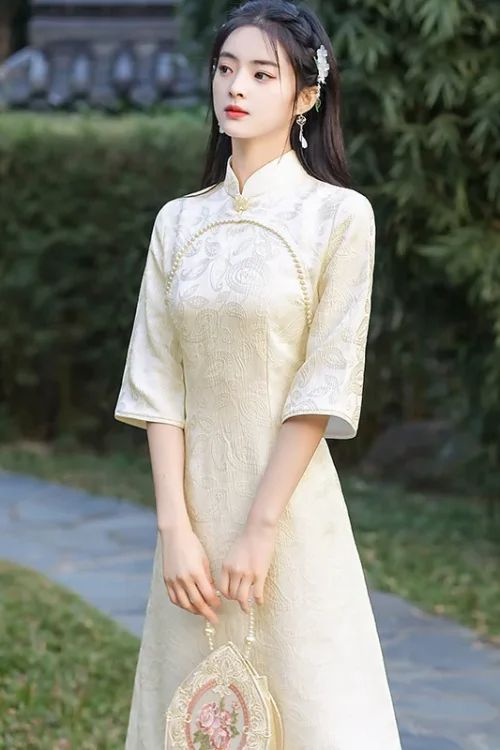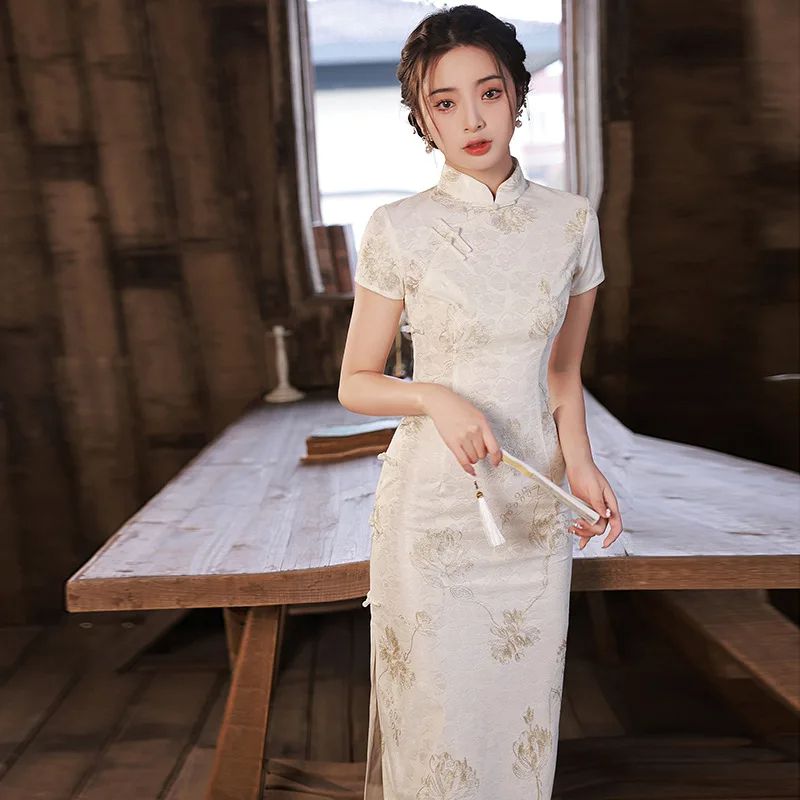The Qipao’s Historical Significance and Cultural Roots
The qipao, an iconic Chinese garment, has experienced a resurgence in popularity in recent years, captivating the fashion world with its timeless elegance and cultural significance. Rooted in the Manchu ethnic minority, the qipao emerged during the Qing dynasty as a symbol of national identity and cultural heritage. Its distinctive silhouette, characterized by a high collar, fitted bodice, and side slits, has remained largely unchanged throughout history.

Historical Significance
Beyond its historical significance, the qipao has also played a pivotal role in shaping Chinese fashion. During the Republican era, it became a symbol of modernity and liberation for women, as they embraced Western influences and sought to break free from traditional gender roles. The qipao’s popularity continued to soar in the 1930s and 1940s, becoming a staple in the wardrobes of stylish women both in China and abroad.
Modern Revival
In recent years, the qipao has undergone a revival, gaining new momentum in modern fashion. Contemporary designers have reimagined the traditional garment, infusing it with fresh perspectives and innovative designs. From vibrant colors and bold patterns to asymmetrical cuts and modern fabrics, the qipao has evolved to meet the demands of today’s fashion-forward consumers.
Factors Driving Resurgence
This resurgence of interest in the qipao can be attributed to several factors. Firstly, there has been a growing appreciation for traditional Chinese culture and heritage, both within China and internationally. The qipao, as a symbol of this heritage, has become a way for people to connect with their cultural roots.
Secondly, the qipao’s versatility and adaptability have made it a popular choice for a wide range of occasions. Whether it is worn for formal events, casual outings, or even as a statement piece, the qipao can be effortlessly styled to suit different tastes and preferences.
Celebrity Influence
Moreover, the qipao’s timeless elegance and flattering silhouette have made it a favorite among celebrities and fashion icons. From Michelle Yeoh to Rihanna, the qipao has been spotted on the red carpets and street style blogs of the world’s most stylish individuals.
Conclusion
As the qipao continues to gain momentum in modern fashion, it is poised to become a global symbol of Chinese culture and heritage. Its enduring appeal lies in its ability to bridge the past and present, embodying both tradition and innovation. Whether it is worn as a nod to history or as a statement of contemporary style, the qipao is a testament to the enduring power of fashion to connect people with their cultural roots.
Modern Interpretations and Contemporary Designs of the Qipao
The qipao, an iconic Chinese garment, has experienced a remarkable resurgence in recent years, captivating the hearts of fashion enthusiasts worldwide. Once relegated to formal occasions, the qipao is now making waves in contemporary fashion, reimagined with modern interpretations and innovative designs.

Historical Background
The qipao’s origins can be traced back to the Manchu dynasty, where it was worn as a symbol of cultural identity. Its distinctive features include a high collar, fitted bodice, and side slits that allow for freedom of movement. Traditionally crafted from luxurious fabrics such as silk and brocade, the qipao exudes elegance and sophistication.
Transformation in the 20th Century
In the 1920s and 1930s, the qipao underwent a transformation, becoming a symbol of female empowerment and modernity. Shanghai, the epicenter of Chinese fashion at the time, witnessed the emergence of qipaos with shorter hemlines, vibrant colors, and intricate embroidery. This evolution paved the way for the qipao’s global recognition.
Contemporary Reinterpretations
Today, designers are reimagining the qipao with a fresh perspective. Contemporary interpretations incorporate elements of Western tailoring, such as structured shoulders and tailored waistlines. The use of unconventional fabrics, such as denim and leather, adds a touch of edginess to the traditional silhouette.
Innovative Designs
Moreover, designers are experimenting with asymmetrical cuts, exaggerated sleeves, and bold prints. These modern designs push the boundaries of the qipao’s traditional form, creating a fusion of heritage and innovation. The result is a garment that is both timeless and utterly contemporary.
Impact on Tradition
The resurgence of the qipao is not merely a fashion trend but a testament to the enduring power of tradition. By embracing the qipao’s rich history while infusing it with modern sensibilities, designers are creating garments that resonate with both fashion-forward individuals and those who appreciate cultural heritage.
Timeless Appeal
As the qipao continues to gain momentum in modern fashion, it serves as a reminder of the enduring appeal of traditional garments. By adapting to the evolving tastes of contemporary society, the qipao ensures its place as a timeless and versatile piece that transcends generations.
The Qipao’s Resurgence in Fashion and Its Impact on Cultural Identity
Introduction
The qipao, an iconic Chinese garment, is experiencing a remarkable resurgence in modern fashion. Once relegated to special occasions, this traditional dress is now making waves on runways and in the wardrobes of fashion-forward individuals. This revival is not merely a trend but a testament to the enduring power of cultural heritage and its influence on contemporary style.

Origins
The qipao’s origins can be traced back to the Manchu dynasty in the 17th century. It was originally worn by women of the upper classes and evolved over time to become a symbol of Chinese identity. The dress is characterized by its form-fitting silhouette, high neckline, and side slits, which allow for freedom of movement.
Mid-20th Century Recognition
In the mid-20th century, the qipao gained international recognition when it was adopted by Chinese actresses and socialites. However, during the Cultural Revolution, it was suppressed as a symbol of bourgeois decadence. After the reforms of the 1980s, the qipao gradually regained its popularity, and today it is once again a celebrated garment.
Factors Behind the Resurgence
The resurgence of the qipao in fashion is driven by several factors. Firstly, there is a growing appreciation for traditional Chinese culture and aesthetics. Designers are incorporating elements of the qipao into their collections, creating modern interpretations that blend tradition with contemporary sensibilities. Secondly, the qipao’s versatility makes it suitable for various occasions, from formal events to casual outings. Its timeless elegance and flattering silhouette appeal to women of all ages and body types.
Cultural Identity
Moreover, the qipao has become a symbol of cultural identity for Chinese people around the world. Wearing a qipao is a way to express pride in one’s heritage and to connect with the past. It is also a statement of empowerment, as the qipao has historically been associated with strong and independent women.
Positive Impact
The revival of the qipao has had a positive impact on the fashion industry and beyond. It has inspired designers to explore new possibilities in traditional Chinese clothing and has fostered a greater appreciation for cultural diversity. Furthermore, it has contributed to a sense of cultural pride among Chinese people and has helped to bridge the gap between tradition and modernity.
Conclusion
As the qipao continues to gain momentum in fashion, it is likely to become an even more prominent symbol of Chinese culture and identity. Its resurgence is a testament to the enduring power of tradition and its ability to inspire and influence contemporary style.
